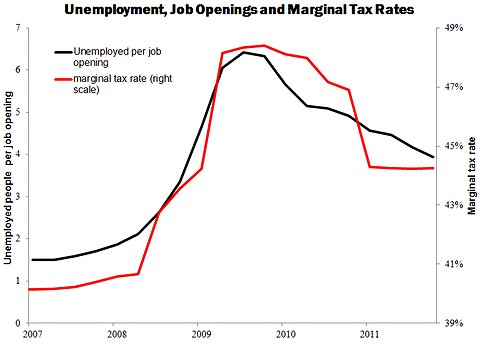
Casey B. Mulligan is an economics professor at the University of Chicago. He is the author of “The Redistribution Recession: How Labor Market Distortions Contracted the Economy.”
A high ratio of unemployed to job openings means that the unemployed are competing a lot for jobs, many news reports say, when in fact it could indicate the opposite.
Today’s Economist
Perspectives from expert contributors.
It’s true that a reduction in labor demand — from, say, a new tax on employers — would motivate employers to get by with fewer employees. As they do, employers would reduce job openings and lay off workers. One result would be fewer job openings and more unemployed people, and thereby more unemployed people per job opening.
But a reduction in labor supply in the form of additional subsidies for unemployed people would have similar effects. Unemployed people would be choosier about the jobs they accept, especially the low-wage ones. With more help for people after layoffs, employers and employees in struggling industries would do less to avoid layoffs, especially layoffs from low-paying positions. Either way the result would be more unemployed people.
Subsidies for unemployed people also make labor more expensive as low-wage jobs are more likely to end by layoff and unemployed people can be choosier about the jobs they take. When labor is more expensive, employers have an incentive to get by with fewer employees and for that reason may well reduce the number of job openings they have.
In this way a reduction in labor supply by itself, a reduction in labor demand by itself or both together can increase the ratio of unemployed to job openings. It makes little sense to point to a high ratio as proof that labor demand is low, because it could just as easily tell us that labor supply is low. All a high ratio tells us is that the labor market has contracted, and that we could readily and more reliably detect without any data on job openings by just looking at the unemployment rate itself, or the ratio of employed to population.
My conclusion is not new to labor economists, who have long understood that supply factors could increase the ratio of unemployed to job openings. Christopher A. Pissarides, a professor at the London School of Economics, literally wrote the book on job openings and unemployment, and his book explains how more generous unemployment compensation would have these effects (see Figure 9.2 from his latest edition; I thank my colleague Robert Shimer for this reference).
The black series in the chart below shows the ratio of unemployed to job openings. The chart also shows in red the marginal tax rate on labor income (the extra taxes paid, and subsidies forgone, as a result of working, expressed as a ratio to the income from working) for a typical head of household or spouse based on the ever-changing eligibility and benefit rules for safety-net programs. The ratio increases fastest between the first half of 2008 and the first half of 2009, just when the marginal tax rate series increases the most. Both series peak in late 2010 and decline thereafter. Neither series has returned to its prerecession level.
 Ratio of unemployed per job opening is calculated from Bureau of Labor Statistics seasonally adjusted monthly figures for number of unemployed and total nonfarm job openings, as provided by the St. Louis Fed. Marginal tax rates are as calculated by Casey B. Mulligan in “The Redistribution Recession” (Oxford University Press, 2012).
Ratio of unemployed per job opening is calculated from Bureau of Labor Statistics seasonally adjusted monthly figures for number of unemployed and total nonfarm job openings, as provided by the St. Louis Fed. Marginal tax rates are as calculated by Casey B. Mulligan in “The Redistribution Recession” (Oxford University Press, 2012).
For the reasons mentioned above, the chart is by no means proof that supply was a major factor during the recession. That proof requires other sorts of analyses, which are shown in my book.
Nevertheless Paul Krugman continues to cite the high ratio of unemployed to job openings as evidence that demand, rather than supply, contracted the labor market: “There are now four job seekers for every job opening, which means that workers who lose one job find it very hard to get another” (see Page 9 of “End This Depression Now!”). He and other economics commentators citing this fact never explain why the very same ratio should not be interpreted as a drop in supply, or as a combination of reduced supply and reduced demand. Instead they contend that the labor market would rebound with still more help for the unemployed.
Believe it or not, Keynesian economics is not the only way to interpret the job openings data.
Article source: http://economix.blogs.nytimes.com/2012/11/14/what-job-openings-tell-us/?partner=rss&emc=rss
Speak Your Mind
You must be logged in to post a comment.